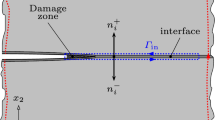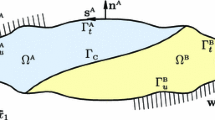Abstract
In modeling a crack along a distinct interface between dissimilar elastic materials, the ratio of mode I to mode II stress intensity factors or energy release rates is typically not unique, due to oscillatory behavior of near-tip stresses and displacements. Although methods have been developed for comparing mode mixes for isotropic interfacial fracture problems, this behavior currently limits the applicability of interfacial fracture mechanics in predicting delamination in layered materials without isotropic symmetry. The virtual crack closure technique (VCCT) is a method used to extract mode I and mode II energy release rate components from numerical fracture solutions. Energy release rate components extracted from an oscillatory solution using the VCCT are not unique due to their dependence on the virtual crack extension length, Δ. In this work, a method is presented for using the VCCT to extract Δ-independent energy release rate quantities for the case of an interface crack between two in-plane orthotropic materials. The method does not involve altering the analysis to eliminate its oscillatory behavior and it is similar to existing methods for extracting a mode mix from isotropic interfacial fracture models. Knowledge of near-tip fields is used to determine the explicit Δ dependence of energy release rate parameters. Energy release rates are then defined that are separated from the oscillatory dependence on Δ. A modified VCCT using these energy release rate definitions is applied to results from finite element analyses, showing that Δ-independent energy release rate quantities result. The modified technique has potential as a consistent method for extracting a mode mix from numerical solutions. The Δ-independent energy release rate quantities extracted using this technique can also aid numerical modelers, serving as guides for testing the convergence of finite element models. Direct applications of this work include the analysis of planar composite delamination problems, where plies or debonded laminates are modeled as in-plane orthotropic materials.
Similar content being viewed by others
References
A.S.D. Wang and F.W. Crossman, Initiation and growth of transverse cracks and edge delamination in composite laminates, Parts 1 and 2. Journal of Composite Materials, sup. vol. (1980) 71–106
T.K. O'Brien, Characterization of delamination onset and growth in a composite laminate. Damage in Composite Materials, ASTM STP 775 (1982) 140–147
S.S. Wang, Fracture mechanics for delamination problems in composite materials. Progress in Science and Engineering of Composites, T. Hayashi, K. Kawata and S. Umekawa (eds) Proceedings ICCM-IV, Tokyo (1982) 287–296
J.R.Reeder and J.H.CrewsJr., Mixed-mode bending method for delamination testing. AIAA Journal 28 (1990) 1270–1276
C.Atkinson, On stress singularities and interfaces in linear elastic fracture mechanics. International Journal of Fracture 13 (1977) 807–820.
J.W.Hutchinson and Z.Suo, Mixed mode cracking in layered materials. Advances in Applied Mechanics, J.W.Hutchinson and T.Y.Wu (eds.) 29 Academic Press, San Diego (1992) 63–191
H.Chai, Experimental evaluation of mixed-mode fracture in adhesive bonds. Experimental Mechanics 32 (1992) 296–303.
B.D. Davidson, Prediction of energy release rate for edge delamination using a crack tip element. Proceedings, Fifth ASTM Symposium on Composite Materials: Fatigue and Fracture, Atlanta (1993) to appear in ASTM STP 1230.
B.D.Davidson, Energy release rate determination for edge delamination under combined in-plane, bending and hygrothermal loading. Part I—delamination at a single interface. Journal of Composite Materials 28 (1994) 1009–1031.
Ibid, Part II—two symmetrically located delaminations. 1371–1392
M.Y.He and J.W.Hutchinson, Kinking of a crack out of an interface. Journal of Applied Mechanics 56 (1989) 270–278
Z.Suo and J.W.Hutchinson, Sandwich test specimens for measuring interface crack toughness. Materials Science and Engineering A107 (1989) 135–143.
J.R.Rice, Elastic fracture mechanics concepts for interfacial cracks. Journal of Applied Mechanics 55 (1988) 98–103.
Z.Suo and J.W.Hutchinson, Interface crack between two elastic layers. International Journal of Fracture 43 (1990) 1–18.
J.W.Hutchinson, M.E.Mear and J.R.Rice, Crack paralleling an interface between dissimilar materials. Journal of Applied Mechanics 53 (1987) 828–832.
P.G.Charalambides, J.Lund, A.G.Evans and R.M.McMeeking, A test specimen for determining the fracture resistance of bimaterial interfaces. Journal of Applied Mechanics 56 (1989) 77–82.
Z.Suo, Singularities, interfaces and cracks in dissimilar anisotropic media. Proceedings of the Royal Society of London A427 (1990) 331–358.
G.R.Irwin, Analysis of stresses and strains near the end of a crack traversing a plate. Journal of Applied Mechanics 24 (1957) 361–364.
I.S.Raju, J.H.CrewsJr. and M.A.Aminpour, Convergence of strain energy release rate components for edge-delaminated composite laminates. Engineering Fracture Mechanics 30 (1988) 383–396.
E.F.Rybicki and M.F.Kanninen, A finite element calculation of stress intensity factors by modified crack closure integral. Engineering Fracture Mechanics 9 (1977) 931–938.
P.P.L.Matos, R.M.McMeeking, P.G.Charalambides and M.D.Drory, A method for calculating stress intensities in bimaterial fracture. International Journal of Fracture 40 (1989) 235–254.
J.T. Wang, I.S. Raju, C.G. Davila and D.W. Sleight, Computation of strain energy release rates for skinstiffener debonds modeled with plate elements. Proceedings 34th AIAA/ASME/ASCE/AHS/ASC Structures, Structural Dynamics and Materials Conference, Part 3, Paper AIAA 93-1501-CP (1993) 1680–1692.
Author information
Authors and Affiliations
Rights and permissions
About this article
Cite this article
Beuth, J.L. Separation of crack extension modes in orthotropic delamination models. Int J Fract 77, 305–321 (1996). https://doi.org/10.1007/BF00036249
Received:
Accepted:
Issue Date:
DOI: https://doi.org/10.1007/BF00036249




